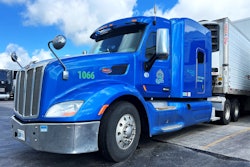
Since the first quarter of 2024 rolled to an end, my communication with many owner-operators reveals little more than unfavorable load offers and little hope for improvement. Broad economic forecasts seem at best mere guesses -- economic data isn’t offering much in the way of concrete guidance or reliable answers.
One week we might see a little bump in rates as some owner-operators try to play the waiting game. Then a load or two shows some promise, more carriers jump all over it, and competition heats up again, pushing rates back down.
In our current business environment, the speed with which load information can be posted and accessed is a double-edged sword -- fast flows of information present opportunity, sure. But the wide array of tech platforms, from brokers’ apps to those of the traditional load boards, seem to get more and more risky when it comes to an individual owner-operator’s ability to evaluate just who can be trusted.
Reaction to these risks yields both untimely hesitation (missing out on this or that good load) or too-fast acceptance, with a mere hope that everything works out.
Many owners have shared with me, too, that they just “don’t have time to do all the math” to figure out if the load is really profitable. “All I know is that I need cash! And I need it now.”
That leaves us with this problem: owners are running with rates in their playbook that are, at best, guesstimates for the cash needed to pay the bills. I’ve written about the value of putting the legwork into knowing what your time is worth, asking other questions meant to stimulate individual pursuit of a sound approach to revenue/cost management. Sometimes, the questions are difficult to answer, I know. It’s often quite tough to drill down to one number. Assessing value, also, gets wrapped up in so much emotion for an individual owner -- it’s tough to simply put pen to paper and figure out day to day.
Math can be taxing, but controlling emotion is much harder
There’s a lot of personal pride tied up in our rationalizations for decisions and actions. Our personal biases rise to the surface like oil in water. If an owner-operator shares that their cost is higher or lower than others seem to think every owner-op’s "normal" cost should be, he opens himself up to ridicule. What’s the effect of that? It’s a chilling one, I know, stifling open communication and information sharing.
I’d like to approach rates from a slightly different angle and encourage you to answer these two questions for yourself:
- What is your acceptable rate?
- And why?
Most owners have a quick answer to the first: “I need $1,000 a day”; … “at least $5,000 a week”; or “… $1.80 per mile,” whatever the case may be.
The second question is more of a conversation starter, because few owners I speak to answer it the same way, if they can answer it at all. Why is this your go-to rate? Getting to the answer yourself, you might find a way to simplify your cost and load evaluation process.
Realistically, it’s probably impossible to expect all owners to grasp business practices that will discourage the acceptance of risky, unprofitable loads. Put another way, it’ll be hard to bring owner-operators together in agreement to refuse to haul “cheap freight,” when as an industry there is no single definition for what cheap freight is!
[Related: Who is really hauling all the cheap freight? Owner-ops weigh in]
Yet with a larger percentage of owners communicating and supporting each other with a commitment to learning, doing the back-office work to estimate costs more accurately and efficiently, we can do ourselves a favor in a market like the present one.
Profit margins are razor-thin. Sitting on outdated cost estimates based on old, stale information is at best risky itself. Where an owner accesses information matters. Gross revenue (load payments incoming) is probably the easiest thing to see -- and one of if not the greatest influence in this business, simply because it makes people feel good.
Revenue prospects draw us in on the load boards, yet load details are often missing. A higher rate than typical for the market is posted, for instance, for a load that is in fact two or more LTL loads grouped together. The broker may not include the deadhead miles between pickup locations, the effect being that the rate per mile looks a good deal better than it really is, encouraging an owner-operator’s quick response: to book the load before knowing the truth.
At once, it’s pretty much accepted that miles posted will always be less than what the operator will have to navigate on the ground. That, of course, impacts the time invested in the load. Do we even dare to question how much time we’ll lose to detention in load evaluations?
In quick load evaluations, too often owners are forced into chasing down data points like this. In overall cost evaluations, too, we dig them out of not only our settlements but several other sources (credit card statements, other separate accounts). Quick, accurate cost evaluation is fundamentally difficult. It’s why we talk fuel prices first when asked about cost, and why we see the topic of fuel prices in the headlines possibly more than any other expense. Fuel cost is a comparatively easy estimate to make (again, though, only as long you know the true miles required of any load).
[Related: Calculate any load's cost in relation to time, not just miles]
So what makes up an accurate cost evaluation?
The unsatisfying (I know) answer: “It’s complicated.”
We are all guilty of rationalizing to find support for what we hope our cost will be. We all struggle trying to use old, stale information fed to us from the past, while the rest of the logistics network (brokers and customers) operate more in the future tense with contracts that offer some reasonable degree of certainty.
One final question to get you thinking: How can we do the same?
[Related: Direct freight: Delivering a modicum of consistency in a turbulent market]
Find more information on load revenue/cost evaluation in Chapters 3 ("Understanding your revenue and costs") and 18 ("Going independent") of the updated Overdrive/ATBS-coproduced "Partners in Business" book for new and established owner-operators, a comprehensive guide to running a small trucking business sponsored for 2024 by the Rush Truck Centers dealer network. Follow this link to download the most recent edition of Partners in Business free of charge.









